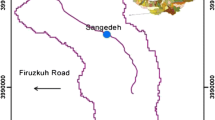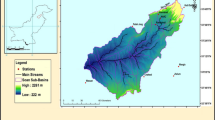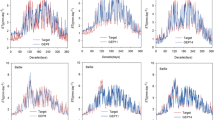Abstract
Presenting temperature data using recently introduced innovative polygon trend analysis (IPTA) can improve our understanding of the effects of climate change. This method was applied to analyze temperature trends at six stations in Turkey: Istanbul (17,064), Ankara (17,131), Bursa (17,116), Iznik (17,661), Gemilik (17,663), and Sakarya (17,069). At station 17,064, there was an increasing trend in temperature data for seven months, while only one month showed a decreasing trend, and the remainder presented no trend. For station 17,131, there was a decreasing trend for two months, an increasing trend for five months, and no trend for the remaining months. At station 17,116, an increasing trend was present for nine months, with a decreasing trend for two months and only one month indicating no trend. An increasing trend over seven months was noted at station 17,661, while two and three months showed a decreasing and no trend, respectively. For station 17,663, there was an increasing trend for nine months, one month showed no trend, and two months presented a decreasing trend. At station 17,069, five, four, and three months showed increasing, decreasing, and no trends, respectively. The gene expression programming (GEP) model was tested to predict the short-term monthly average temperature for this dataset. The proposed GEP model presented good prediction results for all selected stations by tracing the relationship with a coefficient of determination (R-Sq) ≥ 0.90. Trend analysis by IPTA can help understand temperature trends better, aiding future decision-making, and the GEP model can effectively predict short-term values.







Similar content being viewed by others
Data availability
Data that support the findings of this study are available from the Turkish State Meteorological Service, but restrictions apply to the availability of the dataset. Refined data are available from the corresponding author upon request.
References
Abhishek, K., Singh, M. P., Ghosh, S., & Anand, A. (2012). Weather forecasting model using artificial neural network. Procedia Technology, 4, 311–318.
Achite, M., Ceribasi, G., Ceyhunlu, A. I., Wałęga, A., & Caloiero, T. (2021). The innovative polygon trend analysis (IPTA) as a simple qualitative method to detect changes in environment—Example detecting trends of the total monthly precipitation in semiarid area. Sustainability, 13, 12674.
Ahmed, N., Wang, G., Booij, M. J., Ceribasi, G., Bhat, M. S., Ceyhunlu, A. I., & Ahmed, A. (2022). Changes in monthly streamflow in the Hindukush–Karakoram–Himalaya Region of Pakistan using innovative polygon trend analysis. Stochastic Environmental Research and Risk Assessment, 36, 811–830.
Alashan, S. (2018). An improved version of innovative trend analyses. Arabian Journal of Geosciences, 11, 1–6.
Alfarisy, G. A. F., & Mahmudy, W. F. (2017). Rainfall forecasting in Banyuwangi using adaptive neuro fuzzy inference system. JITeCS Journal of Information Technology and Computer Science, 1, 65–71.
Alotaibi, K., Ghumman, A. R., Haider, H., Ghazaw, Y. M., & Shafiquzzaman, M. (2018). Future predictions of rainfall and temperature using GCM and ANN for arid regions: A case study for the Qassim Region, Saudi Arabia. Water, 10, 1260.
Arab Amiri, M., & Gocić, M. (2021). Innovative trend analysis of annual precipitation in Serbia during 1946–2019. Environment and Earth Science, 80, 1–15.
Azamathulla, H. M., Rathnayake, U., & Shatnawi, A. (2018). Gene expression programming and artificial neural network to estimate atmospheric temperature in Tabuk, Saudi Arabia. Applied Water Science, 8, 184. https://doi.org/10.1007/s13201-018-0831-6.
Ceribasi, G., & Ceyhunlu, A. I. (2021). Analysis of total monthly precipitation of Susurluk Basin in Turkey using innovative polygon trend analysis method. Journal of Water and Climate Change, 12, 1532–1543.
Ceribasi, G., & Ceyhunlu, A. I. (2020). Analysis of total monthly precipitation of Susurluk Basin in Turkey using innovative polygon trend analysis method. Journal of Water and Climate Change.
Ceribasi, G., Ceyhunlu, A. I., & Ahmed, N. (2021). Analysis of temperature data by using innovative polygon trend analysis and trend polygon star concept methods: A case study for Susurluk Basin, Turkey. Acta Geophysica, 69, 1949–1961. https://doi.org/10.1007/s11600-021-00632-3.
Danandeh Mehr, A., Nourani, V., Karimi Khosrowshahi, V., & Ghorbani, M. A. (2019). A hybrid support vector regression-firefly model for monthly rainfall forecasting. International Journal of Environmental Science and Technology, 16.
Dong, Z., Jia, W., Sarukkalige, R., Fu, G., Meng, Q., & Wang, Q. (2020). Innovative trend analysis of air temperature and precipitation in the Jinsha River Basin, China. Water, 12, 3293.
Fajfar, I., & Tuma, T. (2018). Creation of numerical constants in robust gene expression programming. Entropy, 20, 756.
Fenta Mekonnen, D., & Disse, M. (2018). Analyzing the future climate change of Upper Blue Nile River basin using statistical downscaling techniques. Hydrology and Earth System Sciences, 22, 2391–2408.
Ghumman, A. R., Ghazaw, Y. M., Sohail, A. R., & Watanabe, K. (2011). Runoff forecasting by artificial neural network and conventional model. Alexandria Engineering Journal, 50, 345–350.
Güçlü, Y. S., Dabanlı, İ, Şişman, E., & Şen, Z. (2019). Air quality (AQ) identification by innovative trend diagram and AQ index combinations in Istanbul megacity. Atmospheric Pollution Research, 10, 88–96.
Hattermann, F. F., Krysanova, V., Gosling, S. N., Dankers, R., Daggupati, P., Donnelly, C., Flörke, M., Huang, S., Motovilov, Y., & Buda, S. (2017). Cross-scale intercomparison of climate change impacts simulated by regional and global hydrological models in eleven large river basins. Climate Change, 141, 561–576.
Hayati, M., & Mohebi, Z. (2007). Application of artificial neural networks for temperature forecasting. International Journal of Electrical and Computer Engineering, 1, 662–666.
Kara, E., Özdilek, H. G., & Kara, E. E. (2013). Ambient air quality and asthma cases in Niğde, Turkey. Environmental Science and Pollution Research, 20, 4225–4234.
Karimi, B., Safari, M., Mehr, A. D., & Mohammadi, M. (2019). Monthly rainfall prediction using ARIMA and gene expression programming: A case study in Urmia, Iran. Online Journal of Engineering Science Technologies, 2, 8–17.
Kauffman, G. J., & Belden, A. C. (2010). Water quality trends (1970 to 2005) along Delaware streams in the Delaware and Chesapeake Bay watersheds, USA. Water, Air, and Soil Pollution, 208, 345–375.
Kisi, O., & Ay, M. (2014). Comparison of Mann-Kendall and innovative trend method for water quality parameters of the Kizilirmak River, Turkey. Journal of Hydrology, 513, 362–375.
Kovačević, M., Ivanišević, N., Dašić, T., & Marković, L. (2018). Application of artificial neural networks for hydrological modelling in karst. Građevinar, 70, 1–10.
Krysanova, V., Vetter, T., Eisner, S., Huang, S., Pechlivanidis, I., Strauch, M., Gelfan, A., Kumar, R., Aich, V., & Arheimer, B. (2017). Intercomparison of regional-scale hydrological models and climate change impacts projected for 12 large river basins worldwide—a synthesis. Environmental Research Letters, 12, 105002.
Landeras, G., López, J. J., Kisi, O., & Shiri, J. (2012). Comparison of gene expression programming with neuro-fuzzy and neural network computing techniques in estimating daily incoming solar radiation in the Basque Country (Northern Spain). Energy Conversion and Management, 62, 1–13.
Mansouri, I., Güneyisi, E. M., & Mosalam, K. M. (2020). Improved shear strength model for exterior reinforced concrete beam-column joints using gene expression programming. Engineering Structures, 111563. https://doi.org/10.1016/j.engstruct.2020.111563
Mehr, A. D., Nourani, V., Kahya, E., Hrnjica, B., Sattar, A. M. A., & Yaseen, Z. M. (2018). Genetic programming in water resources engineering: A state-of-the-art review. Journal of Hydrology, 566, 643–667.
Mishra, N., Soni, H. K., Sharma, S., & Upadhyay, A. K. (2018). Development and analysis of artificial neural network models for rainfall prediction by using time-series data. International Journal of Intelligent Systems & Applications, 10.
Peng, Y., Zhao, X., Wu, D., Tang, B., Xu, P., Du, X., & Wang, H. (2018). Spatiotemporal variability in extreme precipitation in China from observations and projections. Water, 10, 1089.
Pham, T. D., Yoshino, K., & Bui, D. T. (2017). Biomass estimation of Sonneratia caseolaris (l.) Engler at a coastal area of Hai Phong city (Vietnam) using ALOS-2 PALSAR imagery and GIS-based multilayer perceptron neural networks. Giscience & Remote Sensing, 54, 329–353.
Phuong, D. N. D., Hai, L. M., Dung, H. M., & Loi, N. K. (2022). Temporal trend possibilities of annual rainfall and standardized precipitation index in the Central Highlands, Vietnam. Earth Systems and Environment, 6, 69–85.
Rattigan, O. V., Civerolo, K. L., & Felton, H. D. (2017). Trends in wet precipitation, particulate, and gas-phase species in New York State. Atmospheric Pollution Research, 8, 1090–1102.
Şan, M., Akçay, F., Linh, N. T. T., Kankal, M., & Pham, Q. B. (2021). Innovative and polygonal trend analyses applications for rainfall data in Vietnam. Theoretical and Applied Climatology, 144, 809–822.
Şen, Z. (2021). Conceptual monthly trend polygon methodology and climate change assessments. Hydrological Sciences Journal, 66, 503–512.
Şen, Z. (2014). Trend identification simulation and application. Journal of Hydrologic Engineering, 19, 635–642.
Şen, Z. (2012). Innovative trend analysis methodology. Journal of Hydrologic Engineering, 17, 1042–1046.
Şen, Z., Şişman, E., & Dabanli, I. (2019). Innovative polygon trend analysis (IPTA) and applications. Journal of Hydrology, 575, 202–210.
Serinaldi, F., Chebana, F., & Kilsby, C. G. (2020). Dissecting innovative trend analysis. Stochastic Environmental Research and Risk Assessment, 34, 733–754.
Shiri, J., Kim, S., & Kisi, O. (2014). Estimation of daily dew point temperature using genetic programming and neural networks approaches. Hydrology Research, 45, 165–181.
Shiri, J., Marti, P., & Singh, V. P. (2014). Evaluation of gene expression programming approaches for estimating daily evaporation through spatial and temporal data scanning. Hydrological Processes, 28, 1215–1225.
Turkish State Meteorological Service. (n.d.). Turkish State Meteorological Service [WWW Document]. https://mgm.gov.tr/eng/forecast-cities.aspx. Accessed 7 July 21.
Yao, L., & Lu, N. (2014). Spatiotemporal distribution and short-term trends of particulate matter concentration over China, 2006–2010. Environmental Science and Pollution Research, 21, 9665–9675.
Yaqub, M., Eren, B., & Eyupoglu, V. (2019). Soft computing techniques in prediction Cr(VI) removal efficiency of polymer inclusion membranes. Environmental Engineering Research. https://doi.org/10.4491/eer.2019.085
Yaqub, M., & Lee, S. H. (2020a). Experimental and neural network modeling of micellar enhanced ultrafiltration for arsenic removal from aqueous solution. Environmental Engineering Research. https://doi.org/10.4491/eer.2019.261
Yaqub, M., & Lee, S. H. (2020b). Micellar enhanced ultrafiltration (MEUF) of mercury-contaminated wastewater: Experimental and artificial neural network modeling. Journal of Water Process Engineering, 33, 101046.
Yaqub, M., Woo, C., & Lee, W. (2021). Optimization of hypochlorous acid generation by HCl electrolysis through response surface methodology and artificial neural networks. Journal of Environmental Chemical Engineering, 105826.
Yassin, M. A., Alazba, A. A., & Mattar, M. A. (2016). Artificial neural networks versus gene expression programming for estimating reference evapotranspiration in arid climate. Agricultural Water Management, 163, 110–124.
Yurekli, K. (2021). Scrutinizing variability in full and partial rainfall time series by different approaches. Natural Hazards, 105, 2523–2542.
Zhang, H., Zhang, L. L., Li, J., An, R. D., & Deng, Y. (2018). Climate and hydrological change characteristics and applicability of GLDAS data in the Yarlung Zangbo River Basin, China. Water, 10, 254.
Author information
Authors and Affiliations
Corresponding author
Ethics declarations
Conflict of interest
The authors declare no competing interests.
Additional information
Publisher's Note
Springer Nature remains neutral with regard to jurisdictional claims in published maps and institutional affiliations.
Highlights
• Conducted monthly average temperature trend through innovative polygon trend analysis (IPTA).
• Applied and tested the feasibility of the gene expression programming (GEP) model.
• Predicted monthly average temperature for short-term future values using proposed GEP.
• Results showed that IPTA and GEP could trace trends and predict monthly average temperature successfully.
Supplementary Information
Below is the link to the electronic supplementary material.
Rights and permissions
About this article
Cite this article
Yenice, A.C., Yaqub, M. Trend analysis of temperature data using innovative polygon trend analysis and modeling by gene expression programming. Environ Monit Assess 194, 543 (2022). https://doi.org/10.1007/s10661-022-10156-y
Received:
Accepted:
Published:
DOI: https://doi.org/10.1007/s10661-022-10156-y




